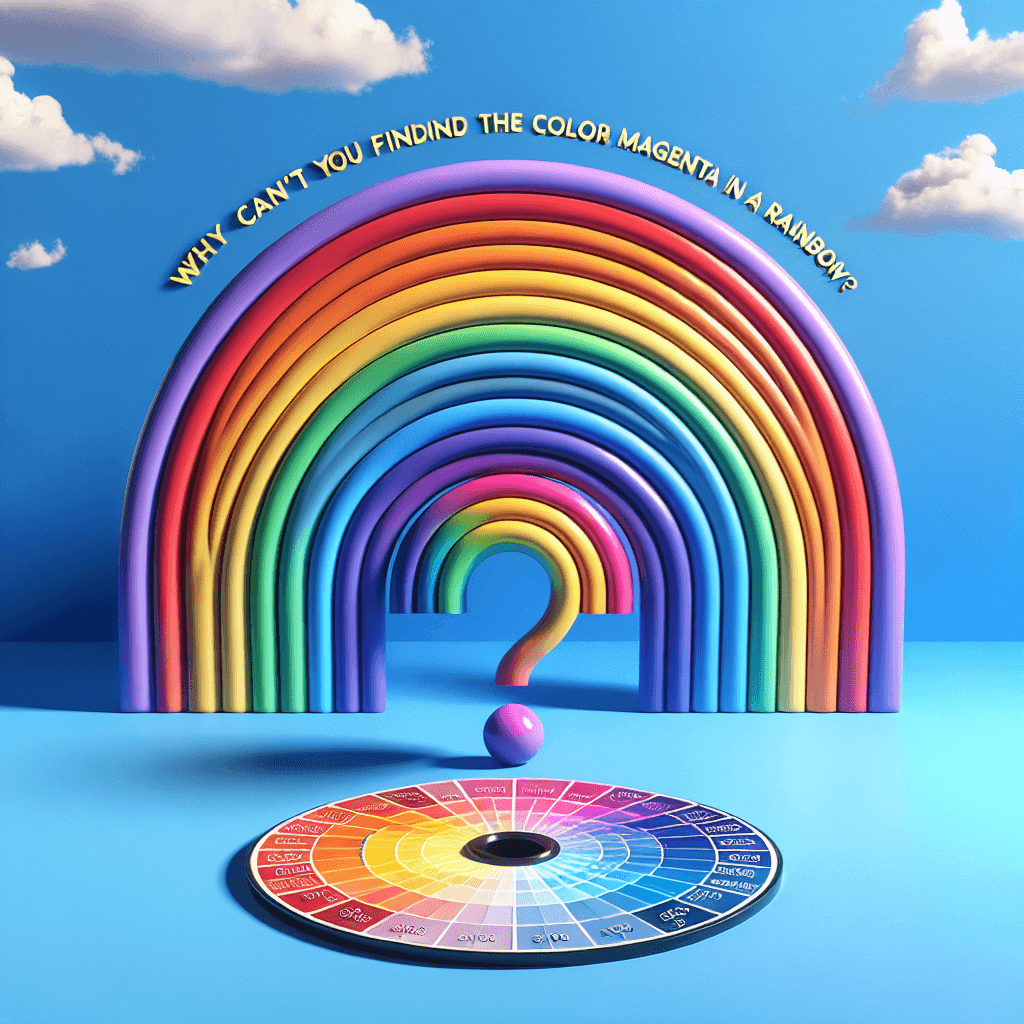Rainbow's Missing Hue: Why Can't You Find the Color Magenta in a Rainbow
We learn the familiar red, orange, yellow, green, blue, indigo, and violet sequence of a rainbow, but why is the popular color magenta conspicuously absent? Discover the fascinating reason this hue never appears in the sky.


Too Long; Didn't Read
Magenta is not part of the visible light spectrum; it's a color our brain creates by mixing red and violet light. Since these two colors are on opposite ends of a rainbow, they don't overlap to create magenta.
Rainbow's Missing Hue: Why Can't You Find the Color Magenta in a Rainbow?
Have you ever stopped to truly gaze at a rainbow, marveling at its vibrant arc across the sky? From childhood, we learn the familiar sequence: red, orange, yellow, green, blue, indigo, and violet. But have you ever noticed a color that’s conspicuously absent? That color is magenta. While it's a popular hue in fashion, art, and design, you'll never spot it nestled between the violet and red in a natural rainbow. This might seem like a simple observation, but the reason behind it delves into the fascinating science of light and how our eyes perceive color. This post will explore exactly why magenta, a color we clearly see and recognize, doesn't earn a stripe in nature's most spectacular light show.
Understanding Rainbows: Nature's Spectrum
To understand why magenta is missing, we first need to grasp how a rainbow is formed. A rainbow is an optical and meteorological phenomenon that is caused by both reflection and refraction of light in water droplets resulting in a spectrum of light appearing in the sky.
When sunlight, which appears white to us, enters a raindrop, it bends (refracts) and disperses into its component colors. Each color of light has a different wavelength. Red light has the longest wavelength, and violet has the shortest. Because these wavelengths are different, they bend at slightly different angles. The light then reflects off the inside back of the raindrop and refracts again as it exits. This process separates the white light into the continuous band of colors we see as a rainbow – the visible spectrum. Think of it as nature's prism effect, writ large across the sky. The colors always appear in the same order (ROYGBIV) because the degree of bending is wavelength-dependent.
How We Perceive Color
Our perception of color isn't just about the light itself; it's about how our eyes and brain interpret that light. The human eye contains specialized photoreceptor cells called cones. Most humans have three types of cones, each most sensitive to different wavelengths of light:
- L-cones: Primarily sensitive to long wavelengths (red light).
- M-cones: Primarily sensitive to medium wavelengths (green light).
- S-cones: Primarily sensitive to short wavelengths (blue light).
Our brain processes the signals from these three types of cones to create the rich tapestry of colors we experience. When light of a specific wavelength enters our eye – say, light with a wavelength of around 650 nanometers – it primarily stimulates the L-cones, and our brain interprets this as "red." Similarly, light around 550 nanometers stimulates M-cones ("green"), and 450 nanometers stimulates S-cones ("blue"). Other spectral colors, like yellow, stimulate both red and green cones, and our brain interprets that combination as yellow.
The Curious Case of Magenta
So, where does magenta fit into this? Here's the key: magenta is not a spectral color. This means it doesn't correspond to a single wavelength of light. You won't find a "magenta wavelength" in the same way you find a "red wavelength" or "blue wavelength."
Instead, magenta is what color scientists call an extraspectral or non-spectral color. Our brain perceives magenta when it receives strong signals from our L-cones (red) and our S-cones (blue) simultaneously, but with little to no stimulation of our M-cones (green). Essentially, magenta is the color our brain "invents" to bridge the gap between red and violet at the ends of the visible spectrum. If you imagine the linear spectrum of a rainbow and bend it into a circle to create a color wheel, magenta is the color that connects violet back to red.
Why No Magenta Stripe in the Sky?
Now we can connect the dots.
- A rainbow is formed by sunlight being dispersed into its constituent single wavelengths of light. Each color band in a rainbow represents a narrow range of these individual wavelengths.
- Magenta is not a single wavelength of light; it's a perception created by a mixture of red light and blue light.
In a rainbow, red light (long wavelength) is bent the least, appearing at the top of the arc, while violet light (short wavelength) is bent the most, appearing at the bottom. There is no physical process in the formation of a rainbow that can take red light from one end of the spectrum and blue/violet light from the other end, and then combine them and direct them to your eye from the same point in the sky. The water droplets are separating the wavelengths, not mixing them in this specific way. The green light, which would need to be absent for us to perceive magenta, is very much present in its own band in the middle of the rainbow.
Therefore, because a rainbow is a pure display of the spectral colors arranged by wavelength, and magenta is a color our brain creates from a specific mix of red and blue light (with an absence of green), it simply cannot appear as a distinct band in a rainbow.
Conclusion: A Trick of the Mind
The absence of magenta in a rainbow isn't an oversight by nature; it's a direct consequence of the physics of light and the biology of our vision. Rainbows beautifully display the array of colors that exist as single wavelengths within sunlight. Magenta, on the other hand, is a testament to the incredible way our brain processes information from our eyes, creating a rich perception of color that goes beyond the simple spectrum. So, the next time you see a vibrant magenta flower or piece of clothing, remember that while you won't find its counterpart in a rainbow, its existence is a fascinating insight into how we perceive the world around us. It highlights that what we "see" is an intricate interplay between the physical world and our own biological interpretation.


